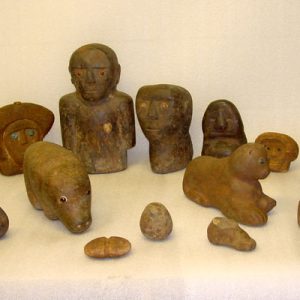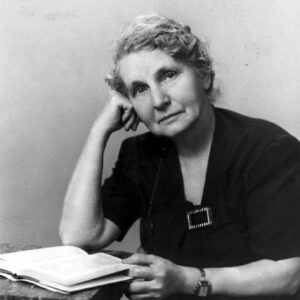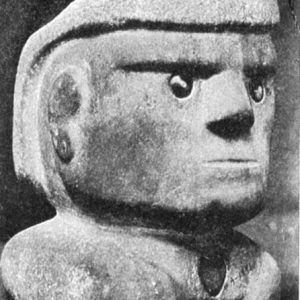calsfoundation@cals.org
King Crowley
King Crowley is the most famous archaeological fake produced in Arkansas and was originally part of a collection “found” in Jonesboro (Craighead County) along Crowley’s Ridge in the 1920s and 1930s. Despite the discoverer’s claim that the collection was an important archaeological find, modern researchers now refer to King Crowley and its companions as folk art instead of forgeries, as the pieces did not reproduce prehistoric artifacts.
Dentler Rowland, a gunsmith and jeweler from Jonesboro, began selling these artifacts of a “lost” civilization in 1923, and he continued to do so until the 1930s. Rowland claimed to have discovered them while digging along Crowley’s Ridge, an erosional remnant within the Mississippi River Delta upon which Jonesboro was founded. Approximately eighty statues and other objects, ranging from crude to expertly crafted human busts or animal caricatures, survive today. All of the figures seem to be crafted of sandstone and artificially stained to appear old. They are embellished with the brass, silver, and steel parts of a horse harness. Though the artifacts are unique and valuable as folk art, they are neither remnants of a “lost” civilization, as Rowland claimed, nor are they representative of some other Native American culture.
The most popular of the artifacts Rowland “discovered” was a small statue later dubbed King Crowley by Bernie Babcock, the founder of the Museum of Discovery in Little Rock (Pulaski County). Along with Jonesboro historian Harry Lee Williams, Babcock argued the authenticity of the find, though experts elsewhere in the state and the nation, including archaeologists at the Smithsonian Institute, never believed the find to be valid. There is reason to believe that by the 1930s even Babcock had relented in her defense of the artifacts. Nonetheless, news of the excavation of King Crowley, who appeared in Arkansas schoolbooks, spread quickly. The discovery, which was controversial from the beginning, made its way throughout the Mid-South, eventually wending its way into newspapers as far north as St. Louis, Missouri. Speculation that King Crowley was four or five thousand years old and had been made by Aztecs generated much excitement because the statue would have been one of the most ancient artifacts of its kind found in North America.
The bust of King Crowley is of a stern-looking young male with hair swept back, metal eyes, metal ear ornaments, and a metal heart set into the chest. The statue is about twelve to fourteen inches tall and weighs about forty pounds, based on observations made before it disappeared with all of Babcock’s correspondence into a collection in California shortly after World War II. This collection of at least thirty-five to forty objects has been relocated, but the present owner remains anonymous. The only other large collection (of thirty-six objects) is in the Arkansas State University museum in Jonesboro.
The reason for the faking of these artifacts remains unknown, and while there seems to be some disagreement over Rowland’s full role in the fiasco, he more than likely at least aided in the creation of the site’s finds. Rowland himself was a fine craftsman whose home stood where a sandstone boulder, identical to the sandstone used to make many of the statues, was found. There is reason to believe that the excitement surrounding the archaeological discoveries in Egypt at the time led Rowland to fake his own discovery of an early civilization—among the animals depicted in the collectionwere a camel and a hippopotamus, which are not native to North America but are found in Egypt.
For additional information:
McCracken, Lloyd, and Dan and Phyllis Morse. “Dentler Rowland and King Crowley and Those Mysterious Stone Images.” Craighead County Historical Quarterly 42 (July 2004): 3–14.
———. “Dentler Rowland and King Crowley and Those Mysterious Stone Images—Part II.” Craighead County Historical Quarterly 42 (October 2004): 21–27.
———. “Dentler Rowland and King Crowley and Those Mysterious Stone Images—Conclusion.” Craighead County Historical Quarterly 43 (January 2005): 22–27.
———. “Dentler Rowland and His Workshop.” Craighead County Historical Quarterly 43 (April 2005): 21–25.
Morse, Dan F., and Phyllis A. Morse. Archaeology of the Central Mississippi Valley. New York: Academic Press, 1983.
Dan Morse
University of Arkansas, Fayetteville
 Archaeological Fakes
Archaeological Fakes  Bernie Babcock
Bernie Babcock  King Crowley
King Crowley 



Comments
No comments on this entry yet.